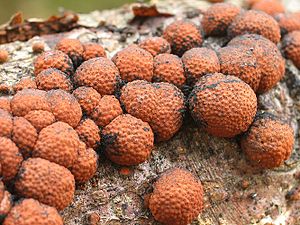Coal berries
| Coal berries | ||||||||||||
|---|---|---|---|---|---|---|---|---|---|---|---|---|

Reddish coal berry ( Hypoxylon fragiforme ) |
||||||||||||
| Systematics | ||||||||||||
|
||||||||||||
| Scientific name | ||||||||||||
| Hypoxylon | ||||||||||||
| Bull. |
The coal berries ( Hypoxylon ) are a genus of tubular mushrooms from the family of the wooden club relatives , whose representatives grow on wood .
features
According to Ju and Rogers (1996), the coal berries are characterized by four main features: First, the main feature of all members of the subfamily Hypoxyloideae must be mentioned, namely that the secondary fruit forms are built up in the form of compact hyphae walls, the conidiophores , according to the type genus of the subfamily " Nodulisporium - called good ". Second, the stroma are uniformly shaped, that is, neither stem nor head are formed. The stroma is the hyphae that is perceived as a supposed fruiting body, but actually only the tiny, conical fruiting body that surrounds the peritecia . Thirdly, the stroma tissue under the perithecial layer is homogeneous and firm and fourthly, the stroma are not upright, but wider than they are tall, so they appear spherical to flat.
In addition, unlike wooden clubs , many species have pigments that dissolve in potassium hydroxide . They are therefore often colored.
ecology
The coal berries are saprobionts or weak parasites, most species inhabit wood, some also other plant remains, animal excrement or soil. Petrini and Petrini (1985) report endophytic coal berries in living plants.
Types (selection)
The genus contains around 170 species worldwide. The previously common division into the sections Hypoxylon and Annulata has been removed. The latter section is now listed as the genus Annulohypoxylon . Almost two thirds of the species are found in the tropics and subtropics. A disproportionately large number of taxa have been described from New Zealand.
European species include:
- Reddish coal berries ( H. fragiforme Pers.) J. Kickx f. (1835)
- Red-brown coal berries ( H. fuscum Pers .: Fr.) Fr. (1849)
- Cinnamon -brown or small- pore coal berries ( H. howeianum ) Peck (1872)
- Moravian coalberry ( H. moravicum ) Pouzar (1972)
- Brick-red coal crust ( H. rubiginosum Pers.) Fr. (1849)
- Hypoxylon rutilum Tul. & C. Tul. (1863)
- Ash- coalberry ( H.fraxinophilum ) Pouzar (1972)
- Hypoxylon aeneum Nitschke
- Hypoxylon chestersii Rogers & Whalley (1978)
The compressed coal berries ( Annulohypoxylon cohaerens ) and the multiform coal berries ( Annulohypoxylon multiforme ) are now separated from Hypoxylon (see above).
meaning
The coal berries are inedible, but play an important role in the forest ecosystem as wood decomposers.
swell
- Ju, Y.-M., and JD Rogers. 1996. A revision of the genus Hypoxylon . Mycologia Memoir no.20. APS Press, St. Paul, MN. 365 pp.
- A. Bollmann, A. Gminder, P. Reil: List of illustrations of large European mushrooms. 4th edition, genre CD, Black Forest mushroom teaching show, Hornberg 2007, ISSN 0932-920X
- Heinrich Dörfelt , Gottfried Jetschke (Ed.): Dictionary of mycology. 2nd Edition. Spectrum Academic Publishing House, Heidelberg / Berlin 2001, ISBN 3-8274-0920-9 .
- Josef Breitenbach, Fred Kränzlin (Ed.): Mushrooms of Switzerland. Contribution to knowledge of the fungal flora in Switzerland. Volume 1: Ascomycetes (Ascomycetes). 2nd, corrected edition. Mykologia, Luzern 1984, ISBN 3-85604-011-0 .
- Petrini, LE, E. Muller. 1986. Main and secondary crop forms of European Hypoxylon species (Xylariaceae, Sphaeriales) and related fungi. Mycologia Helv. 1: 501-627.
Web links
Individual evidence
- ↑ Ju, Y.-M, & JD Rogers. 1996. A revision of the genus Hypoxylon. Mycologia memoir no.20. APS Press, St. Paul, MN. 365 pp.
- ↑ Petrini, LE, and O. Petrini. 1985. Xylariaceous fungi as endophytes. Sydowia 38: 216-234.
- ↑ Hsieh H.-M., Ju Y.-M. & JD Rogers. 2005. Molecular phylogeny of Hypoxylon and closely related genera. Mycologia 97: 844-865.
- ↑ http://mycology.sinica.edu.tw/xylariaceae/GenusHypoxylon.asp#ACCEPT Accepted taxa
- ↑ Hsieh, HM; Ju, YM; Rogers, JD. 2005. Molecular phylogeny of Hypoxylon and closely related genera. MYCOLOGIA 97: 844-865. doi : 10.3852 / mycologia.97.4.844 .